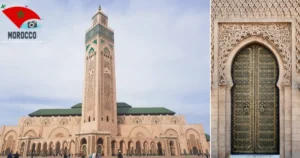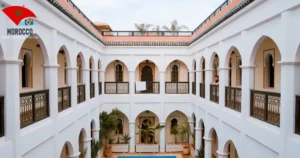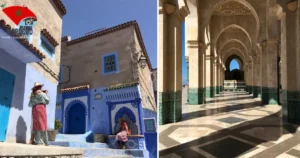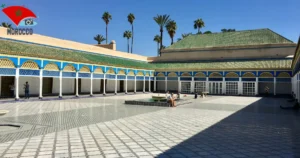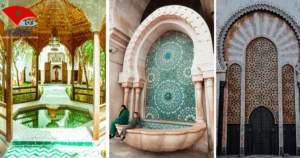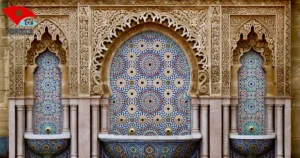Moroccan architecture, a captivating blend of cultural influences and artistic craftsmanship, stands as a testament to the rich history of this North African nation. From traditional riads hidden in bustling medinas to contemporary structures embracing sustainable practices, Moroccan architecture weaves a narrative that transcends time.
Introduction
-
Definition of Moroccan Architecture
Moroccan architecture encompasses a distinctive style characterized by intricate geometric patterns, vibrant colors, and a harmonious blend of diverse cultural influences. It reflects the nation’s identity, history, and the spirit of its people.
-
Historical Significance
Rooted in centuries of history, Moroccan architecture carries the imprints of various civilizations, from the indigenous Berbers to the Arab and Andalusian influences. Its evolution mirrors the dynamic cultural landscape of Morocco.
-
Key Features
Key features include the use of Zellige, a mesmerizing mosaic art form, and the design of riads, traditional Moroccan houses centered around an internal courtyard. These features not only serve functional purposes but also contribute to the aesthetic charm.
Traditional Moroccan Architecture
-
Riads: Hidden Gems
Riads, often tucked away in the labyrinthine medinas, are architectural gems that offer an oasis of tranquility. Characterized by their inward focus and intricate details, riads provide a glimpse into traditional Moroccan living.
-
Zellige: The Art of Mosaic
Zellige, the intricate mosaic art, graces walls, floors, and fountains with vibrant patterns. This ancient craft not only adds visual appeal but also tells stories of the cultural and historical influences that have shaped Moroccan design.
-
The Role of Courtyards
Courtyards, central to traditional architecture, serve as communal spaces fostering social interaction and offering respite from the bustling outside world. The design emphasizes privacy while promoting a sense of community.
Islamic Influences
-
Mosques and Minarets
Islamic architecture has profoundly influenced Moroccan design, evident in the grandeur of mosques and minarets. The intricate calligraphy and geometric patterns showcase a devotion to both art and spirituality.
-
Geometric Patterns
Geometric patterns, a hallmark of Islamic art, adorn various architectural elements, symbolizing unity, balance, and the infinite nature of creation. These patterns echo across Moroccan structures, creating a sense of visual harmony.
Blend of Cultures
-
Berber Influence
The indigenous Berber culture contributes unique elements to Moroccan architecture, from distinctive building materials to design motifs. This influence showcases the resilience and deep-rooted heritage of the Berber people.
-
Arab and Andalusian Fusion
The Arab and Andalusian influences, borne from historical interactions, manifest in the arches, domes, and ornate detailing. This fusion creates a captivating architectural language that defines Morocco’s cultural diversity.
Modern Moroccan Architecture
-
Contemporary Trends
In the contemporary landscape, Moroccan architects are embracing modernity while preserving cultural identity. Innovative designs incorporate cutting-edge technology and materials, reflecting a dynamic fusion of tradition and progress.
-
Sustainable Practices
With a growing awareness of environmental concerns, sustainable practices are becoming integral to Moroccan architectural endeavors. Incorporating eco-friendly materials and energy-efficient designs, architects are pioneering a greener approach.
Famous Architectural Sites
-
The Kasbah of the Udayas
Perched on a hill overlooking the Bou Regreg River, the Kasbah of the Udayas is a historic fortress and a prime example of Moroccan military architecture. Its narrow alleys and whitewashed walls evoke a sense of timeless beauty.
-
Jardin Majorelle in Marrakech
Designed by the French artist Jacques Majorelle, the Jardin Majorelle is a botanical garden and artist’s landscape featuring vibrant blue buildings. This oasis in the heart of Marrakech is a testament to the fusion of nature and architecture.
-
Hassan II Mosque in Casablanca
The Hassan II Mosque, with its stunning oceanfront location, is a masterpiece of modern Moroccan architecture. Its grandeur and intricate details, including the world’s tallest minaret, make it a symbol of the nation’s devotion and architectural prowess.
Preservation Efforts
-
Challenges Faced
Despite the cultural significance, Moroccan architecture faces challenges such as urbanization, inadequate funding, and a lack of awareness. Preservation efforts are crucial to safeguarding these architectural treasures.
-
Initiatives for Conservation
Various initiatives, both governmental and non-governmental, are working towards the conservation of Moroccan architecture. These efforts include restoration projects, educational programs, and community involvement to ensure the legacy endures.
Moroccan Architecture in Pop Culture
-
Films and Media Representation
Moroccan architecture has found its way into international films and media, contributing to the nation’s global allure. The iconic settings of Moroccan cities serve as cinematic backdrops, inviting audiences to explore the mystique of the country.
-
Impact on Tourism
The enchanting allure of Moroccan architecture plays a pivotal role in attracting tourists. The unique blend of tradition and innovation creates an immersive experience, making Morocco a sought-after destination for architectural enthusiasts.
Future Trends
-
Innovation in Design
The future of Moroccan architecture holds promise with architects exploring innovative designs that bridge tradition and modernity. From sustainable urban planning to avant-garde structures, the evolving landscape reflects a commitment to progressive design.
-
Global Influences
As Morocco engages with the global community, architectural influences from around the world find their way into local designs. This intercultural exchange contributes to the evolution of Moroccan architecture, ensuring its continued relevance on the global stage.
Conclusion
In conclusion, Moroccan architecture is a timeless tapestry that weaves together the threads of history, culture, and artistic expression. From the intricate details of traditional riads to the grandeur of modern mosques, each architectural marvel tells a story of Morocco’s enduring legacy.
Frequently Asked Questions (FAQs)
- What makes Moroccan architecture unique? Moroccan architecture is unique due to its blend of Berber, Arab, and Andalusian influences, characterized by intricate geometric patterns, vibrant colors, and a harmonious fusion of diverse cultural elements.
- How has modernization impacted Moroccan architecture? Modernization has led to a fusion of tradition and progress in Moroccan architecture. Architects are incorporating contemporary designs and sustainable practices while preserving the cultural identity.
- What are the challenges faced in preserving Moroccan architecture? Preservation efforts face challenges such as urbanization, insufficient funding, and a lack of awareness. These issues necessitate concerted efforts to safeguard architectural treasures.
- Which famous sites showcase the beauty of Moroccan architecture? The Kasbah of the Udayas, Jardin Majorelle in Marrakech, and the Hassan II Mosque in Casablanca are iconic sites that exemplify the beauty and diversity of Moroccan architecture.
- How does Moroccan architecture contribute to tourism? The enchanting allure of Moroccan architecture, with its unique blend of tradition and innovation, significantly contributes to attracting tourists. The architectural marvels serve as a key draw for visitors exploring the rich cultural heritage of Morocco
LSI Keywords: Moroccan interior design, Islamic architecture, Cultural influences on architecture, Historical significance of Moroccan buildings
